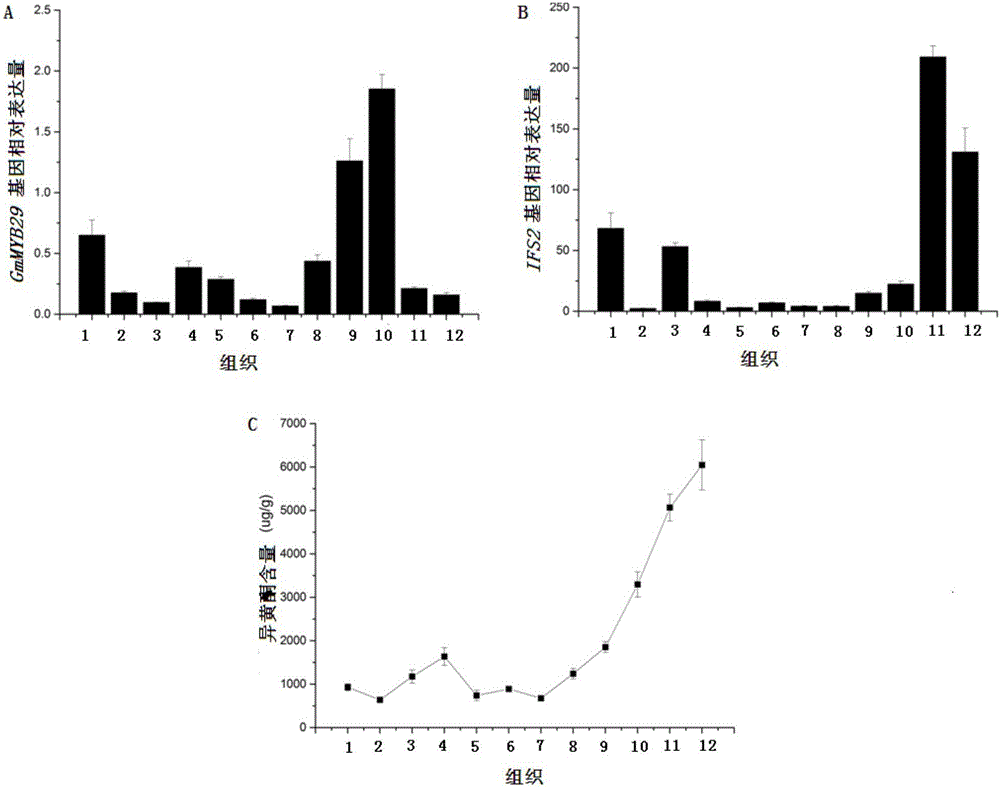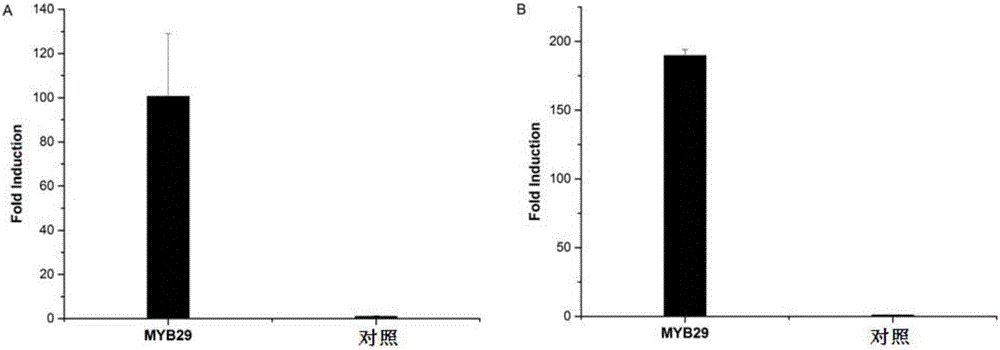MYB type transcription factor GmMYB29 of Glycine max as well as encoding gene and application of transcription factor GmMYB29
A transcription factor, soybean technology, applied in application, genetic engineering, plant genetic improvement, etc., can solve the problems of not reaching a significant level of increase, increasing accumulation of isoflavones, and difficult survival of transgenic plants.
- Summary
- Abstract
- Description
- Claims
- Application Information
AI Technical Summary
Problems solved by technology
Method used
Image
Examples
Embodiment 1
[0028] Example 1, cDNA cloning and identification of soybean GmMYB29 and its coding gene GmMYB29
[0029] The total RNA of leaves of soybean variety Williams82 was extracted with plant total RNA extraction kit (purchased from Tiangen Company), and the integrity of RNA was detected by 1% agarose gel electrophoresis. Synthesis of cDNA refers to TaKaRaPrimerScript TM The RTreagentkitwithgDNAEraser kit explains the operation. Design primers:
[0030] GmMYB29-F: '5-CGGGTCTTTGGAAACGAA-3' (SEQ ID NO.3)
[0031] GmMYB29-R: '5-CGCATTACTCTGGCTGGT-3' (SEQ ID NO.4);
[0032] Prepare PCR reaction solution (50μl system) according to the following components: 25μl 10×PCRBuffer, 9μlddH 2 O, 10 μl ldNTP, 1.5 μl primers (SEQ ID NO.3 and SEQ ID NO.4), 2 μl cDNA and 1 μl KODFX enzyme. The reaction was carried out on a BIO-RADPTC-200 PCR instrument. The program was denaturation at 94°C for 2 minutes; followed by 33 cycles at 98°C for 10 sec, 53°C for 30 sec, and 68°C for 2 min; then extended ...
Embodiment 2
[0033] Example 2, Expression Analysis of GmMYB29 in Different Soybean Tissues
[0034] Under normal field growth conditions for the soybean variety Jianli Niu Maohuang, the roots, stems, leaves, and flowers were taken at the full flowering stage, the pods and seeds were taken 10 days after flowering (10DAF), and the 20DAF, 25DAF, 30DAF, 40DAF, 50DAF and fully mature soybeans were taken. Seeds, all collected samples were quick-frozen in liquid nitrogen and stored at -80°C. The extraction of total RNA and the inversion of cDNA were the same as in Example 1. The Tubulin gene expressed constitutively in soybean was used as an internal reference gene, and the sequences of specific primers and TaqMan-MGB probes were as follows:
[0035] Specific primers and probes for amplifying GmMYB29:
[0036] Upstream primer: 5'-GCCAGGAAGAACTGACAATGAGA-3' (SEQ ID NO.5)
[0037] Downstream primer: 5'-TGGAATTGGAATCAGAACGTTTAAT-3' (SEQ ID NO.6)
[0038] MGB probe: 5'-AGTCCAAGCCAAGTTCCAAAAAGAGCCAC...
Embodiment 3
[0046] Example 3, GmMYB29 regulates the transient expression activity analysis of key genes IFS2 and CHS8 promoters for isoflavone synthesis
[0047] The expression vector for GmMYB29 transcriptional activity analysis in Arabidopsis protoplasts was transformed from pAN580 vector. Double digestion was performed with BamHI and NotI restriction endonucleases, the GFP fragment was removed, the blunt end was treated with Klenow enzyme, and then T4 ligase was used to construct an intermediate vector. In the multiple cloning site segment of the intermediate vector, the GmMYB29 sequence cloned in Example 1 was cloned and connected to form a CaMV35S::GmMYB29 recombinant plasmid, which was used as an effector vector after correct sequencing.
[0048] Choose XbaI and XmaI two enzyme cutting sites to design primers and use the pGL3 vector as a template to amplify the complete ORF of LUC by PCR. After enzyme digestion, recovery, and T4 ligase ligation, the multiple cloning site segment con...
PUM
 Login to View More
Login to View More Abstract
Description
Claims
Application Information
 Login to View More
Login to View More - R&D
- Intellectual Property
- Life Sciences
- Materials
- Tech Scout
- Unparalleled Data Quality
- Higher Quality Content
- 60% Fewer Hallucinations
Browse by: Latest US Patents, China's latest patents, Technical Efficacy Thesaurus, Application Domain, Technology Topic, Popular Technical Reports.
© 2025 PatSnap. All rights reserved.Legal|Privacy policy|Modern Slavery Act Transparency Statement|Sitemap|About US| Contact US: help@patsnap.com



